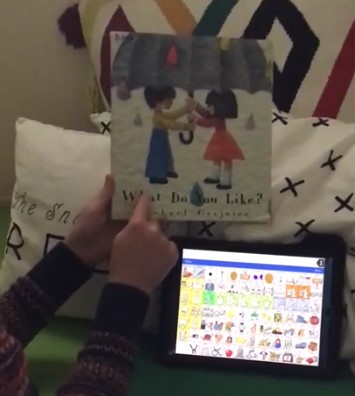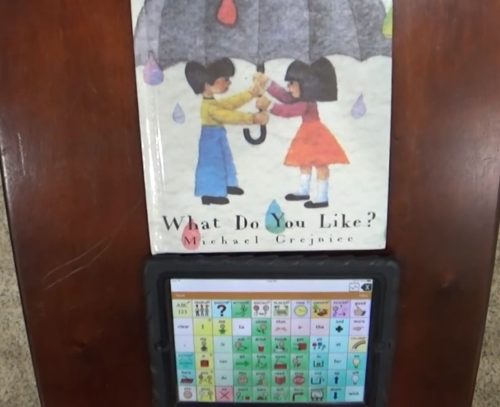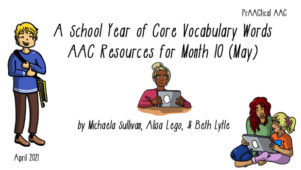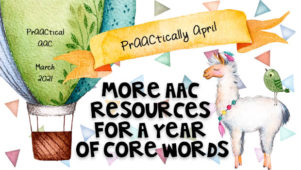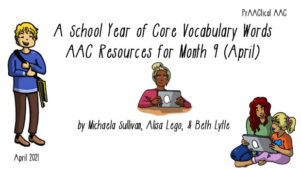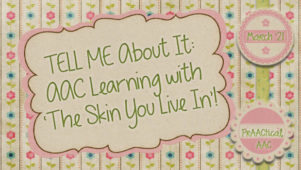TELL ME About It: AAC Learning with ‘What Do You Like?’
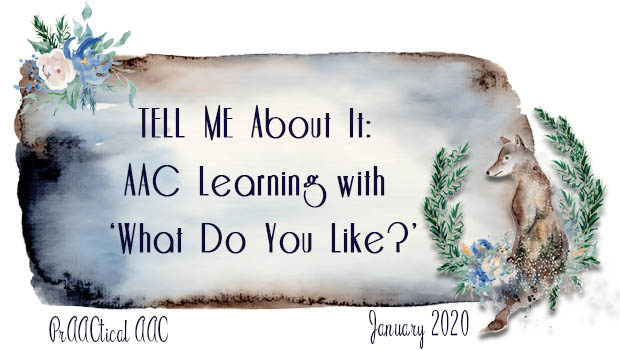
Welcome back to another installment of TELL ME About It, guest authored by Jeanna Antrim and Maggie Judson. Maggie and Jeanna are speech-language pathologists who work in the Assistive Technology Department for the Belleville Area Special Services Cooperative (BASSC) in southern Illinois. They are AT/AAC facilitators and provide evaluations, direct therapy, consultations, and trainings with school teams. In this series, they discuss how they support preschool teachers who are implementing the TELL ME program with their young students.
Today, they walk us through the ways that they facilitate AAC use while focusing on the book ‘What Do You Like?’ Don’t miss their Lesson Plan, video demonstrations, and other resources at the end of the post.
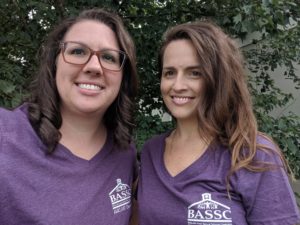
TELL ME About It: AAC Learning with ‘What Do You Like?’
TELL ME About Reading: The fifth book in the TELL ME program (Teaching Early Language and Literacy through Multimodal Expression) is “What Do You Like?”. The ability to comment and share opinions is such a powerful communication function for our students, and this book is an excellent introduction to that skill. ‘I like rainbows,’ ‘I like cats,’ ‘I like to play’ – there is repeated practice to talk about things you like and to express an opinion about preferences! And of course, we’ll be using the book to teach a LOT of core words. For “What Do You Like?”, the target words are LIKE, DO, YOU, WHAT – but the core word exposure doesn’t stop there! Reviewing the previous book’s target words is addressed with “What Do You Like?”, as we are halfway through the TELL ME program!
Here are some ideas of how to work in that review of all those core words:
- Put all the words or picture symbols you have been making each week into a fun sensory bin so students can see (and say!) the words while getting their sensory on.
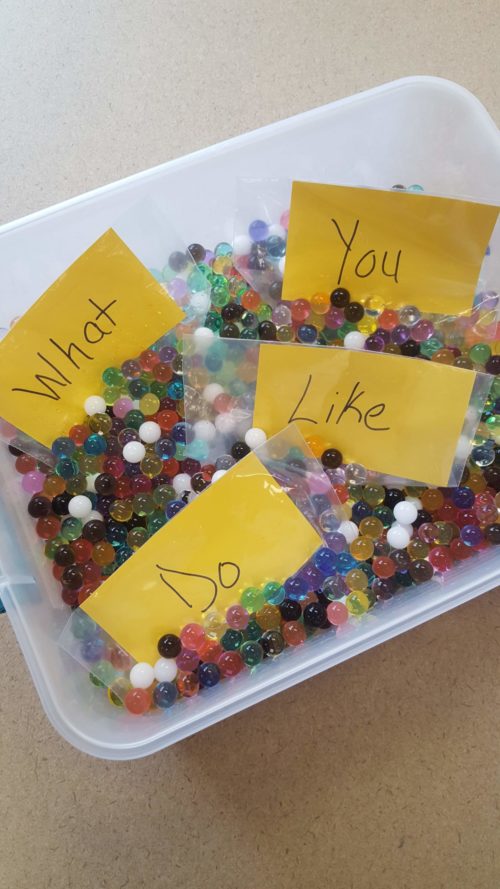
- Program a mid-tech speech output communication device with all the words and let students have fun exploring it during free time or during a center activity.

- Gather up all the TELL ME books from previous weeks and let students vote for their favorite and least favorite. Oh, and work in those core words!: “WHAT one DO YOU LIKE? WHAT one don’t YOU LIKE?”.
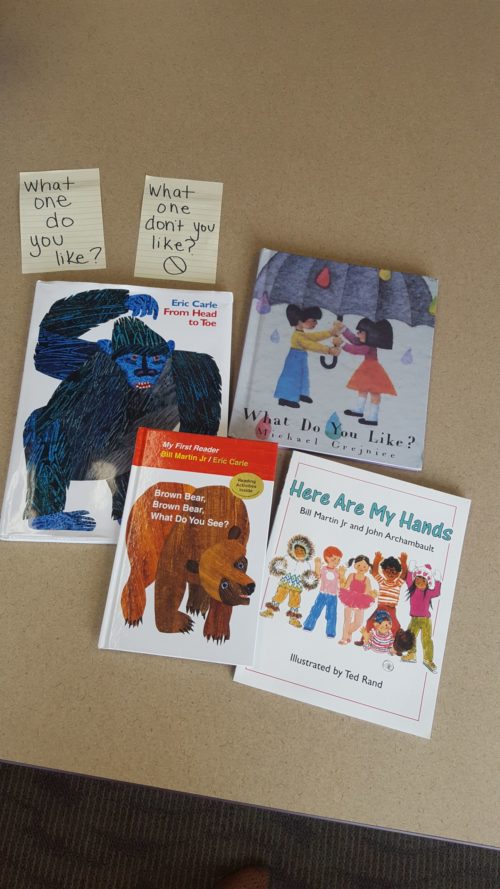
Book Focus: What Do You Like
- Core Words (BOW WOW Words): LIKE, DO, YOU, WHAT
- Additional Words (Tiger Talk Words): review previous words
- Concept Vocabulary: high-interest words
- Special Letter: t
- Book Concept: turning the pages
TELL ME About Writing: “Preschoolers’ exposure to and participation in literacy-enriched activities are crucial for building and strengthening their emergent literacy skills” (Gabas et al., 2019). And shared writing lessons are great literacy-enriched activities to provide exposure to and practice of SO many skills! Some of these skills include core word learning, letter recognition, word recognition, and name recognition. Today’s shared writing lesson works in all these skills, including that name recognition practice!
- Before Writing: First, review those core words – LIKE, DO, YOU, WHAT – to work in that repeated exposure! Then, review the title of the chart – I LIKE ME – pointing to each word as you go.
- Writing: Today’s activity has students matching their name to the sentences they wrote in the previous lesson – yay for name recognition practice! After matching their name to their sentence, read the sentence together with the student. Say something like, “Let’s READ WHAT YOU wrote!” and point to each word as you slowly read it, allowing the student to read along.
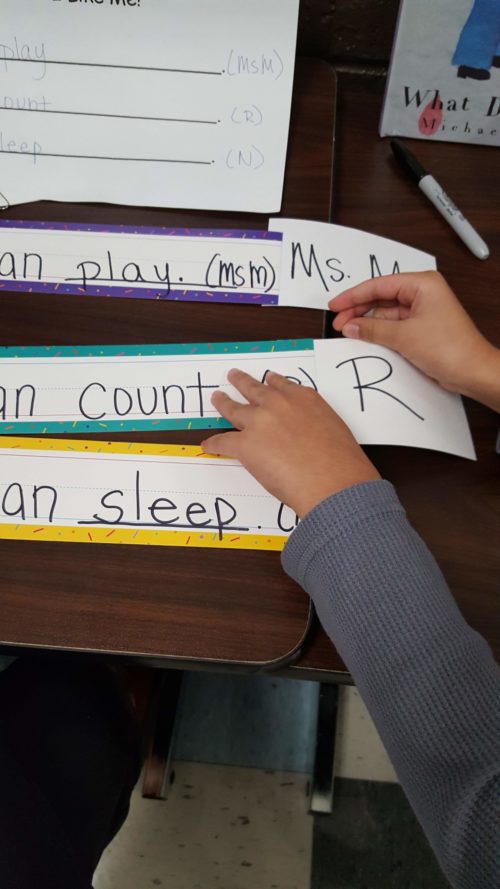
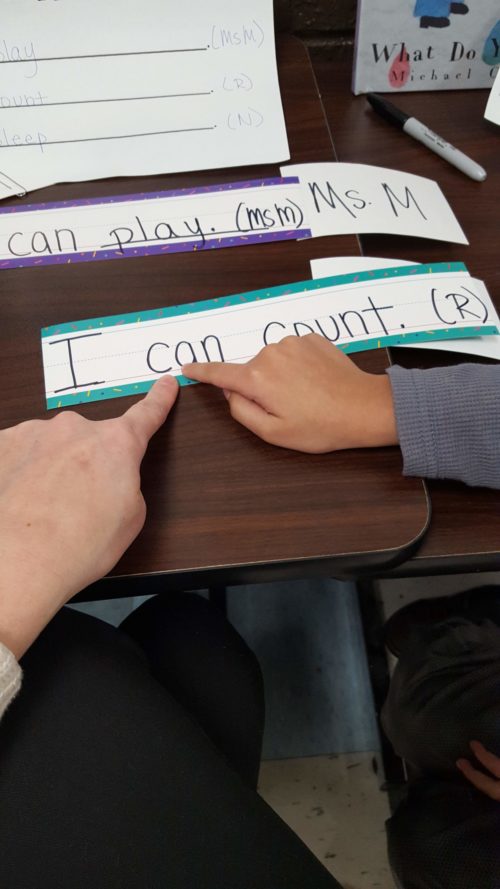 Last but not least, work the special letter in! Support students to find the letter ‘t’ in the chart, then highlight it and say the letter name and sound.
Last but not least, work the special letter in! Support students to find the letter ‘t’ in the chart, then highlight it and say the letter name and sound. 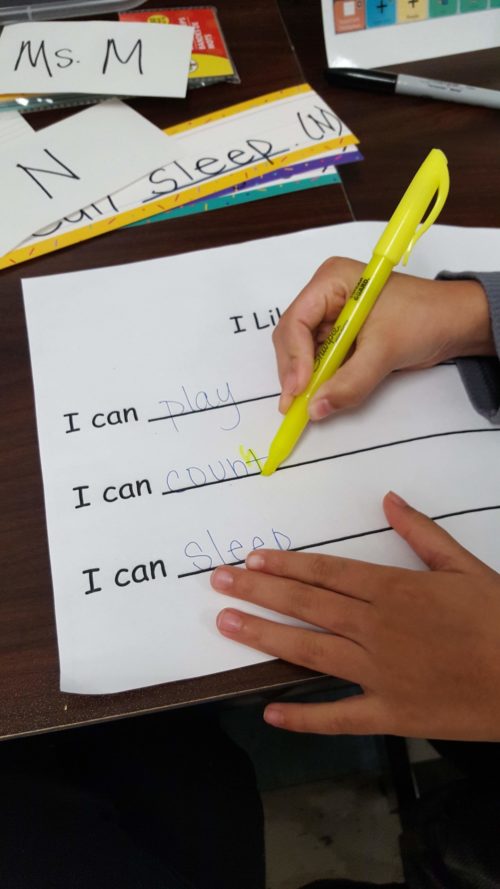
- After Writing: Do a little follow-up activity! Sing the letter song for ‘t’ (“every letter makes a sound!”) to work in more exposure to the letter name and letter sound.

TELL ME More: Below are some specific ideas on how to implement “What Do You Like?” in your therapy sessions and classrooms TELL ME-style!
- Activity – Writing: Providing access to vocabulary for predictable chart writing!
Students with complex communication needs may not have a personally owned speech-generating device when they enter preschool or an early childhood special education classroom. However, to participate in writing, students need access to a range of vocabulary to be able to dictate a response during these activities. Implementing a variety of AAC supports in the classroom can provide students with choices of vocabulary to use during predictable chart writing.
There are a variety of ways to provide access to AAC supports! Think about using:
- a student’s personally owned speech-generating device if they have one!
- shared classroom devices (low-, mid-, and/or high-tech)
- manual communication boards
- choice boards specific for the activity
- device simulators downloaded to a classroom computer (some to check out: http://bit.ly/nuvoicepass; http://bit.ly/saltillochateditor; http://bit.ly/snapcorefirstforwindows). These resources provide access to vocabulary support AND a keyboard as an interactive tool for teaching and for classroom participation!
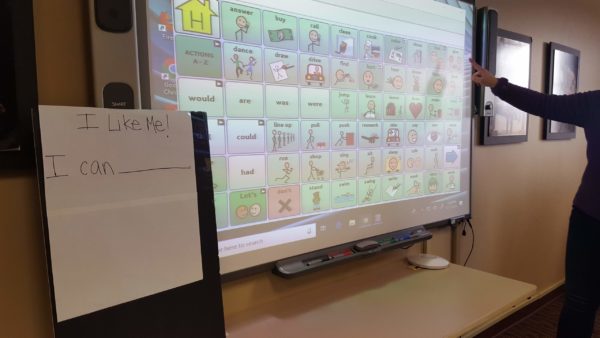
- Teaching Strategy – Writing: Just do it!
Independent writing is another important activity to provide to students on the daily! Letter-by-letter generative writing allows students the opportunity to interact with the full 26 letters of the alphabet to work on letter names, letter sounds, phonological awareness, spelling, and writing skills. In the words of Caroline Musselwhite, “All students must have access to the full alphabet to make progress in learning to read and write” (literacyforallinstruction.ca).
Typically when students enter school, they have spent hundreds of hours experimenting with crayons, markers, and pencils to scribble, draw, and write. This experimenting provides so much learning about literacy concepts! From scribbling, drawing, and writing, children learn things like:
- what print is
- what it is used for
- why it is used
- how it is made
For students with complex communication needs to learn these literacy concepts, they too must get the same types of experiences with writing! “Writing is an essential component of literacy instruction for students without disabilities and a part of their daily instruction. In order for students with significant disabilities to develop as readers and writers, daily writing is equally, if not, more important” (literacyforallinstruction.ca).
An easy way to work in this independent writing is to use the alphabet books included in each TELL ME book packet. Provide students the opportunity to generate their own thoughts and ideas with a pencil or alternative pencil (such as a letter board, keyboard, or alphabet flipbook). 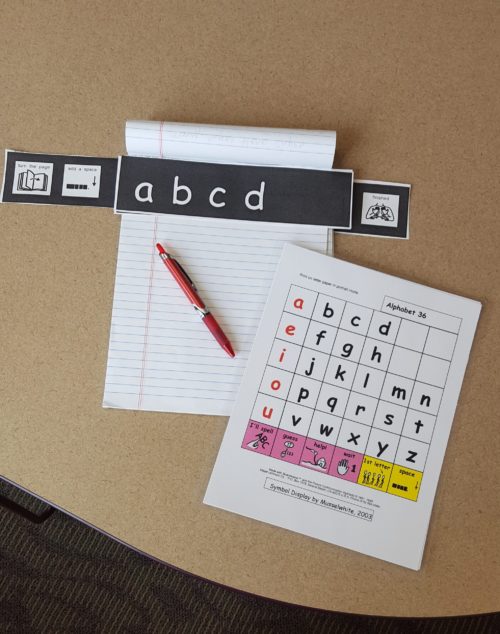 Attributing meaning to writing attempts, through instructional feedback, supports students to make connections and meaning to what they wrote. Below are some examples of instructional feedback you can use during independent writing!
Attributing meaning to writing attempts, through instructional feedback, supports students to make connections and meaning to what they wrote. Below are some examples of instructional feedback you can use during independent writing!
- “I see a ‘t’ in your writing, let’s find all the t’s that you wrote!”
- “I see you wrote a ‘t’. Your friend has a ‘t’ in her name, let’s write her name with the ‘t’!”
- “I see you did some writing. Tell me about what you wrote!”
- Implementation Tip – Different ways to participate in writing!
There are so many different ways to infuse writing opportunities for authentic reasons into the school day, beyond just predictable chart writing activities. The idea is to support students to write, and then to write some more!
Ideas include:
- sign-in during morning meeting
- sign up for daily jobs
- voting for activities or favorite items
- labeling projects
- describe projects
- writing letters to family members
- making remnant books
- making squishy books – Our love for squishy books is strong! To learn more about them, check out our post here.
- go on a letter hunt for the special letter
- play lots of fun alphabet activities and games
- Aided Language Input Tip – Don’t forget spelling!
Providing aided language input for letter-by-letter generative writing with a keyboard is a great way to provide exposure to letter names, letter sounds, and spelling. No AAC system, no matter how robust, can provide access to all the vocabulary you want or need all the time – but with access to the alphabet, you can spell anything you want!
Provide aided language input of spelling by modeling with an alphabet board words not available on the AAC system. Talk it out as you are doing it – “Hmmm, the word I want to say isn’t here. Let’s spell it!”
One easy way we like to provide access to the alphabet for our students is to include it on the back of a manual communication board. Typically the back of communication boards are blank. That’s a lot of wasted space, so take advantage of it! Attach a keyboard on the back, so students have access to the alphabet all day long! 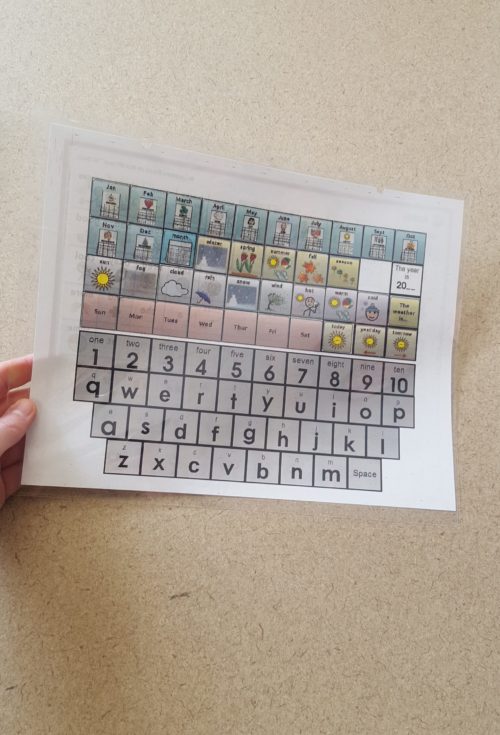
- Goal Ideas – Providing shared reading and writing opportunities directly relates to IEP goals, as these activities align with various core standards. Here are some examples you may find applicable:
- ELA-Literacy.W.K.8 With guidance and support from adults, recall information from experiences or gather information from provided sources to answer a question.
- ELA-Literacy.CCRA.W.10 Write routinely over extended time frames (time for research, reflection, and revision) and shorter time frames (a single sitting or a day or two) for a range of tasks, purposes, and audiences.
Check out the videos of us reading the book “What Do You Like?” while providing aided language input for the target core words.
Reading with LAMP Words for Life
Direct Link to Video: https://www.youtube.com/watch?v=fmZ0gOTeuwY&feature=youtu.be
Reading with WordPower 60 Basic
Direct Link to Video: https://www.youtube.com/watch?v=4BiWufwUoh0&feature=youtu.be
To read more about how we prepare for a TELL ME week, check out our previous posts in the TELL ME About It series!
Be sure to check back next month as we work through the TELL ME manual and share activities, teaching strategies and implementation tips for the next book in the program, “Go Away Big Green Monster”!
REFERENCES and RESOURCES:
- http://literacyforallinstruction.ca/independent-writing-2/
- http://literacyforallinstruction.ca/alternative-pencils-2/
- Alternative Pencils: https://www.med.unc.edu/ahs/clds/alternative-pencils/ and http://www.aacintervention.com/site/cpage.asp?cpage_id=180029277&sec_id=180009852#2011apr
- You can purchase the TELL ME manual from the Attainment Company (www.attainmentcompany.com/) or from ASHA (bit.ly/2XF1w1r). You can learn more about the program by watching the webinar TELL ME: AAC for the Preschool Classroom presented by Dr. Carole Zangari, available from Saltillo (bit.ly/2RNpykn).
- You can learn more about the program by watching the webinar TELL ME: AAC for the Preschool Classroom presented by Dr. Carole Zangari, available from Saltillo (bit.ly/2RNpykn).
- You can find our Lesson Planning form and a template for “What Do You Like?” here.
Follow us on Instagram @basscAAC and subscribe to our YouTube channel (basscAAC) for more AAC implementation ideas!
Filed under: Featured Posts, PrAACtical Thinking
Tagged With: core vocabulary, Jeanna Antrip, Maggie Judson, reading, TELL ME, writing
This post was written by Carole Zangari
